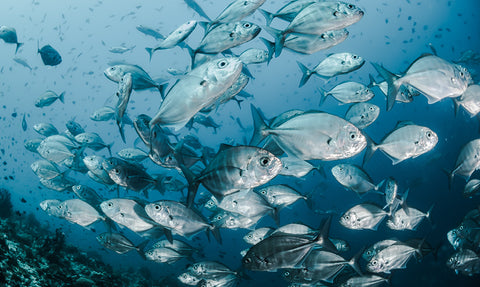
The washing liquid we choose for our dishes and laundry can have a big impact on the environment. Many commercial products contain a cocktail of chemicals which are known carcinogens and toxic to the environment – sulphates, triclosan and phthalates to name just a few.
Usually, when chemicals enter the wastewater system, they are filtered into a treatment plant but some can remain toxic as residue is discharged back into the surface or groundwater, bioaccumulating over time (1). These chemicals may cause endocrine system disruption in fish, leading to reproductive disorders, neurological issues and cancer. As other animals consume these fish, the toxins bioaccumulate through the food chain, with the potential to affect entire ecosystems and human health.
Sulphates
Sulphates, otherwise known as surfactants, are used in some commercial products to help lift the dirt from clothing – they lower the surface tension between two liquids or liquid and solid.
Surfactants such as Sodium Lauryl Sulphate (or the very similar Sodium Laureth Sulphate (SLS & SLES)) are used as foaming agents in many shampoos, body washes, hand washes and laundry products. It is commonly derived from petroleum and then exposed to harsh chemicals when processed. They can cause irritation and skin rashes (2). The byproduct from SLS and SLES production is 1,4-dioxane, a known carcinogen (3).
Sulphates are also highly toxic to aquatic organisms – they break down the mucus layer that protects fish from parasites and bacteria, leaving them exposed to disease (4). Some don’t easily break down or dilute creating an environment where waterways are more likely to absorb pollutants and pesticides.
Triclosan
Used as an antibacterial and antifungal agent in some Australian washing liquids, triclosan has been linked to numerous health problems – skin irritation (especially in children), interference with hormone function and potential links to increased risk of food allergies (5). More recently it has been conclusively linked to liver cancer in mice (6) and has been proven to be an environmental toxin – it doesn’t break down and kills aquatic bacteria in waterways. Triclosan has been detected in dolphins, fish and even earthworms (5).
One human exposure study found that serum concentrations were as much as twofold higher in Australia than in Sweden, where consumer use of triclosan is discouraged (7).
Alarming studies from the US found that 97% of breastmilk contained traces of triclosan and it was detected in 60-100% of waterways across the country (6). Triclosan has been banned by The European Union which classified it as toxic to aquatic life. It has the potential to impact aquatic eco-systems by interfering with hormone function and inhibiting the healthy reproduction of aquatic organisms (8).
Phthalates
Phthalates (pronounced THAL-ates) are used to help the fragrances last longer which is why they are used so extensively. In household goods, look out for the word ‘…phalate’ in the ingredient names. Synthetic ‘fragrance’ or ‘parfum often contains Diethyl phthalate.
Beyond ‘fragrance’, when they are listed, common ones to look out for include
- DNOP (di-n-octyl phthalate)
- DiNP (diisononyl phthalate)
- DEP (diethyl phthalate)
- BBzP (benzyl butyl phthalate)
- DEHP (di 2-ethylhexl phthalate)
- DiDP (diisodecyl phthalate)
- DnHP (di-n-hexyl phthalate)
- DMP (dimethyl phthalate)
- DnOP (di-n-octylphthalate)
- Bisphenol A (BPA) is another plasticizer.
This range of chemicals is known to disrupt the body’s hormones – also called ‘endocrine disruptors’ (9). They have also been linked to obesity, fertility issues, breast cancer and asthma (10). They have also been shown to affect aquatic organisms with some phthalates acting as endocrine disruptors in aquatic life (11), with birds and mammals further affected along the food chain.
Sources:
- https://cen.acs.org/environment/pollution/14-Dioxane-Another-forever-chemical/98/i43
- https://www.healthline.com/health/beauty-skin-care/sulfates#controversy
- https://cen.acs.org/environment/pollution/14-Dioxane-Another-forever-chemical/98/i43
- https://www.greenmatters.com/p/detergent-environmental-effects
- https://pubs.acs.org/doi/full/10.1021/es500495p
- https://health.ucsd.edu/news/releases/pages/2014-11-17-dirty-side-of-soap.aspx
- https://www.ncbi.nlm.nih.gov/pmc/articles/PMC3945593/
- https://eur-lex.europa.eu/LexUriServ/LexUriServ.do?uri=OJ%3AL%3A2008%3A353%3A0001%3A1355%3Aen%3APDF
- https://pubs.acs.org/doi/full/10.1021/es500495p
- https://health.ucsd.edu/news/releases/pages/2014-11-17-dirty-side-of-soap.aspx
- https://www.ncbi.nlm.nih.gov/pmc/articles/PMC3945593/
- https://www.thealternativedaily.com/flushing-toxic-chemicals-drain/
Image source: unsplash.com / Sebastian Pena Lambarri


